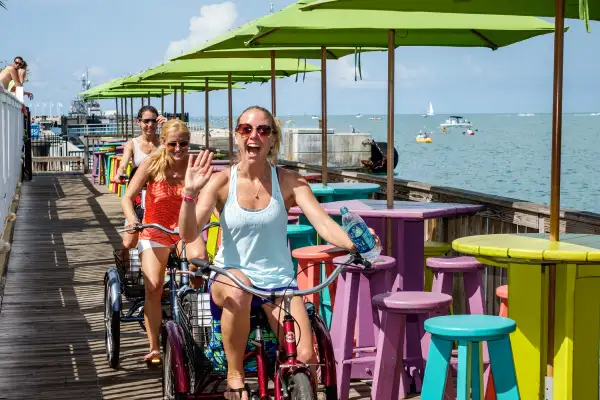Best Places for Walking and Biking

It's hard to deny the benefits of walking and biking: Not only are cities and towns with higher percentages of residents who rely on these modes of transportation to get to work correlated with lower levels of diabetes, high blood pressure, and obesity than less active towns, they're also reaping economic benefits. The Alliance for Biking and Walking found in its 2014 Benchmark Report that increasing these activities has "a positive impact on job growth, individual transportation costs, retail sales, traffic congestion, air quality, property values and stability, health and worker productivity, and events and tourism."
With all of that in mind, Money scoured our database of 1,900 towns to find the places where the highest percentage of residents walk or bike to work, a proxy for general cycle- and walkability. At least 18% of the population in these five towns use their own two feet (or wheels), compared with the national average of just 1% (cycling) to 3% (walking). In our top town, more than 30% of residents walk or bike, a truly astounding figure. —Alicia Adamczyk
5
Port Royal, S.C.
Is there anything better than a long walk on the beach? Certainly not in Port Royal, a town on Port Royal Island located between the Beaufort River and Battery Creek in South Carolina's Lowcountr. Though there's plenty more to do. The town boasts hundreds of miles of coastline for visitors to enjoy, and is home to the Cypress Wetlands, scores of tranquil walking paths and trails, and the Port Royal Boardwalk Park, known locally as the Sands, which features a boardwalk along the marsh.
The Spanish Moss Trail, a 15-mile long "rails-to-trails greenway project" currently under construction, connects Port Royal to other towns in Beaufort County and is used as a path for walking, biking, jogging, and inline skating. It is part of the East Coast Greenway, a nearly 3,000-mile greenway that will eventually link major cities along the Atlantic coast from Maine to Key West, Fla. More than 32% of Port Royal's residents walk or bike to work—the most of all of the 1,900 towns Money surveyed.
4
Northfield, Minn.
Around 26% of Northfield, Minnesota's population of 20,437 walk or bike to work—and for good reason. The natural beauty of the area, located along the shores of the Cannon River and just south of the Twin Cities, is tough to beat. Northfield’s Riverwalk offers views of the river, shopping opportunities, and even a waterfall. The Cowling Arboretum at Carleton College provides approximately 880 acres of conservation area for visitors to use to take walks, jog, play sports, and hang out, in addition to the city's 35 other parks.
The town is the the midst of the Mill Towns State Trail, a 3-mile-long recreational route slated to link Northfield and other nearby towns. Northfield also hosts road races for novice and advanced bikers, including the Jesse James Bike Tour. Nearby St. Peter, Minn., also ranked highly on walk and bike list.
3
Princeton, N.J.
Though it can't claim the tropical climate of Key West, about 24% of Princeton, N.J.'s population walks or bikes to work, no doubt thanks in part to Princeton University. But an abundance of state parks, campgrounds, and other outdoor attractions also give Princeton an edge outside of the 9-to-5 commute. The Delaware-Raritan Canal State Park, Princeton Battlefield State Park, Barbara Boggs Sigmund Park, Greenway Meadows, and the Institute Woods/Charles W. Rogers Wildlife Refuge are just a handful of locations in the city's limits that attract walkers and bikers.
Promoting an active lifestyle also appears to be a civic duty: There's a dedicated advisory committee in city government that is working on a Bicycle Master Plan to make biking in the streets safer, and a team of residents who are promoting walkability through grassroots organizing.
2
Key West, Fla.
There are some obvious factors that make Key West one of the best towns for walking and biking: With gorgeous coastlines, warm weather, and lush vegetation, there's hardly a more beautiful spot to be in the great outdoors. But the island's historic architecture, plentiful parks, conservatories and gardens, and manageable size (it's under 8 square miles) also make Key West great for getting around without a car. (And in fact, just under 21% of the island's residents walk or bike to work.)
The Key West Historic District in Old Town is the largest historical district on the U.S. Department of the Interior's National Register of Historic Places, with more than 3,000 wooden buildings dating from about 1886 to 1912. At just two miles by two miles, it's the perfect size for a walking or biking tour. The Walking Guide to Historic Key West, initially published by historian and preservationist Sharon Wells in 1984, remains a popular guide to the city.
1
Carlisle, Pa.
Carlisle, just outside of Harrisburg, Pa., lies in the heart of the Cumberland Valley, making it the perfect backdrop for cyclists, runners, and nature lovers of all types. The Cumberland Valley Rail Trail, a former railway that was transformed into a 9.5 mile path for walking, jogging, bicycling, horseback riding, and other non-motorized recreational uses, ends just one mile outside of Carlisle's limits. Bike lanes from Carlisle to the trail are currently in the works.
Inside the borough's limits, the Parks & Recreation Department recently completed a 13.8-mile network of trails for residents and visitors to walk, bike, and run across (and around) town, connected to many of the major landmarks and attractions and 18 different parks. And the locals have noticed: of a population of 18,945, over 18% of residents walk or bike to work.